May 2015 : Crete
LaterEarlier |
The plan: Having arrived in Crete last September we gradually realised that it is not exactly an ideal cruising ground for yachts. The island is subject to very strong winds both summer and winter with briefer interludes of calmer weather in the autumn and spring. There are few safe locations for yachts - the north coast has only 3 ports and one serviced marina, between which there are bays which are often untenable due to the north winds screaming down from the Aegean. The south coast has even fewer harbours with a barren, rugged steep-to coastline prone to fearsome and unpredictable gusts. We were keen to see something of the island, but realised this would be better done by land than by sea. We decided therefore to start our land activities in Crete early enough to allow us to get away from the island before the infamous Meltemi (strong northerly wind which dominates the Aegean from mid June) sets in. We are hoping to reach the far north of the Aegean over the summer, but will need to make a somewhat meandering course in order to avoid these headwinds – which will of course give us a chance to visit lots of islands. The trip as the crow flies would be around 350 miles – not terribly ambitious, but our route will take us considerably further. We may of course also find ourselves having to navigate the collapse of the Greek financial system – whatever that may mean. We spent the winter in the somewhat DIY marina in the port of Rethymno, about a third of
the way from the western end of Crete. As we felt our berth was slightly precarious we
paid Aremiti a visit in January to have a look at winter conditions for ourselves.
Secretly hoping for calm, clear, sparkling winter weather, the wind started picking up
as soon as we arrived. The week threw everything at us – 50 knot winds, torrential rain
and snow – the most they have had in Crete for 12 years. We returned to the boat early in May to hear that Crete had experienced an unusually severe and wet winter, and so were relieved to find Aremiti in great shape. The same could not be said of the fire hydrant positioned on the pontoon just where the bow must have surged in at some stage, even though we were positioned a couple of metres out from the pontoon - Aremiti had definitely come off best. We immediately got down to our pre-cruising preparations, having moved the boat to a rare alongside berth. Julia set to recoating the teak, re-painting the deck, spring cleaning the interior, doing a major food re-stock, and cleaning dinghy. Chris worked at the routine engine checks, washing the seriously mucky ropes and deck, refitting the deck gear, polishing the coaming, wiring in USB power sockets, diving to scrape weed and barnacles off the propellor and generally getting us set up for the summer. We had accomplished much of what we needed to do by the time our walking friends arrived
four days later, to stay in a villa nearby.
On Bob's final day we moved across to Heraklion in a rolling sea to deliver him to the airport. We approached the large port of Heraklion with some dread. All the pilot information about berthing there is extremely negative with options ranging from highly unlikely to seriously unsatisfactory/dangerous. Bob was given anchoring training in preparation for mooring stern-to. The harbour was deserted with acres of flat water, despite warnings of hectic shipping movements. Noting the options of the main harbour wall (little to tie to + protruding rebar) and outside the Port Authority offices (very high wall + likelihood of fouling the anchor), we proceeded into the Venetian Harbour, not expecting to find a space but were lucky enough to find about 4 empty berths with alongside pontoons – luxury beyond our wildest dreams! The berth we chose turned out to belong to a yacht currently in the shipyard - perfect! Checking in at the Port Authority – a drab warren of offices where we climbed two flights of stairs to the office to pay our dues - we were charged the grand sum of 8.86 euros. Chris cheekily asked how much the cruise ship Oriana, in port the previous day, had paid. The official obligingly checked in the same receipt book to find that they paid 1500 euros!
Bob departed for his flight late afternoon – leaving us to set off for a walk around the
mighty Venetian walls of the city. The next day we continued eastwards along the coast motor-sailing without enough wind to make the 40 mile leg in reasonable time. As we puttered along happily observing the barren mountainous coastline and odd coastal resort and feeling grateful for good current going our way, the propellor suddenly started vibrating alarmingly. Stopping the boat, resident hero Chris went into the water to find and remove a large plastic bag caught up in the prop - and we continued on our way. Finally after several hours, the forecast wind piped up and we got sailing on genny and mizzen, encountering the typical wind acceleration effect as we rounded Ak Ioannis.
The final leg of the month was 10 miles into the marina at Aghios Nikolaos. Bearing in
mind a forecast of strong winds the following day, we set off early into some already
ominous looking weather. Berthed safely in the rather tight marina, full of British
boats, we spent an afternoon being buffeted by strong winds come early. We arranged a
haul-out for the following day (requiring a great deal of information including the full
names of both Chris' parents) to carry out the annual hull scrub and re-anti-fouling
which hadn't been possible in Rethymno. At this point Julia left the boat to return home
for a week of family committments, leaving Chris with the fun of scraping and painting
the hull and replacing wind generator bearings.
|
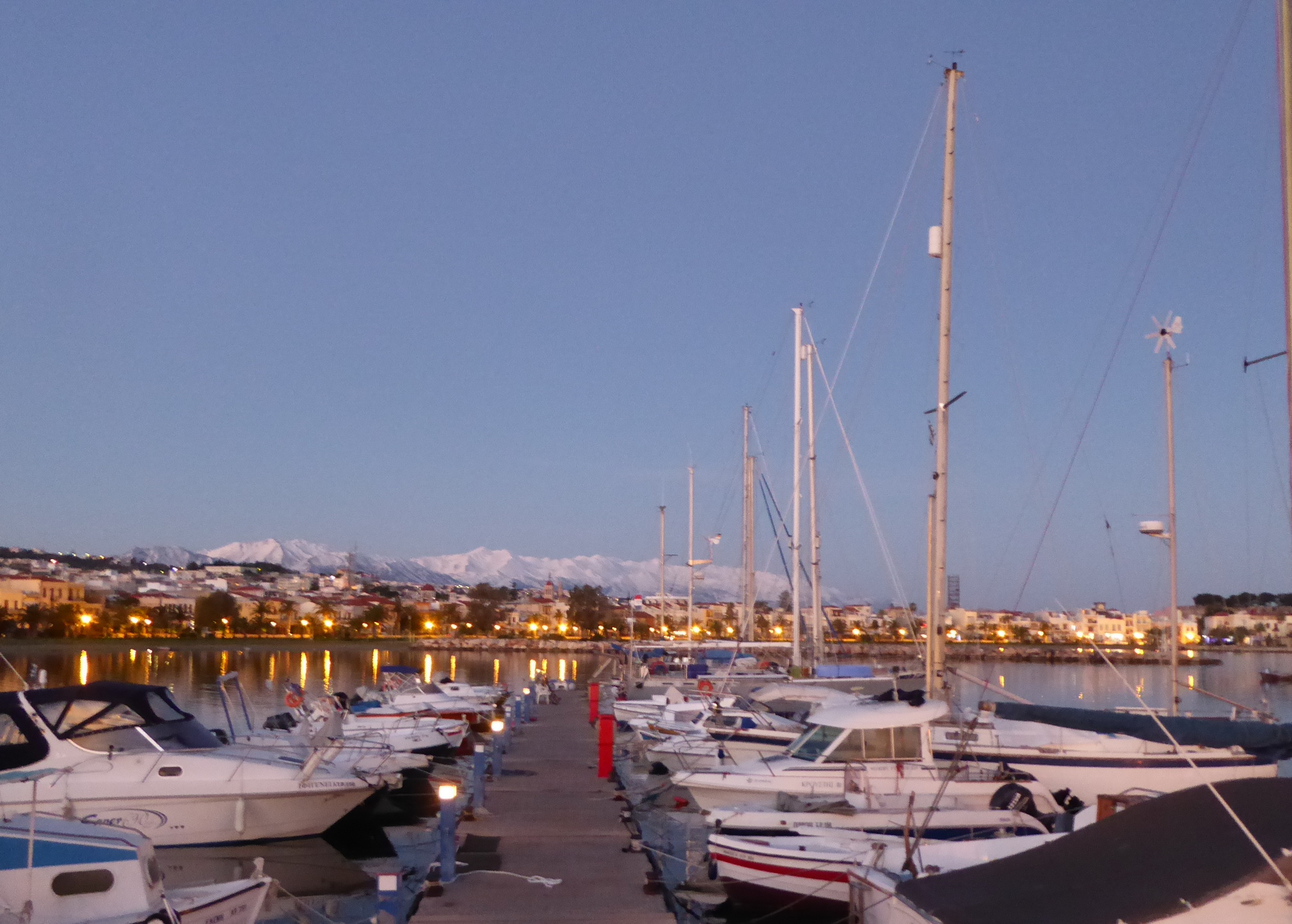 It was very exciting and we
were actually quite pleased to have experienced these conditions. We were very snug in
the boat (once we'd acquired a cheap fan heater) and later in the week went out for a
couple of wonderful drives through the snowy mountain landscape – the sight of trees
laden with ripe oranges, in the snow, was quite bizarre. As conditions improved Chris
found the resolve to brave the water to check and re-tie some of the under-water stern
lines attached to blocks and chain on the sea-bed and even added a 5th line for good
luck. There is a small community of liveaboards at the marina. It was good to get to
know them and to be reassured that they would keep an eye on Aremiti in our absence –
more than the marina would do.
It was very exciting and we
were actually quite pleased to have experienced these conditions. We were very snug in
the boat (once we'd acquired a cheap fan heater) and later in the week went out for a
couple of wonderful drives through the snowy mountain landscape – the sight of trees
laden with ripe oranges, in the snow, was quite bizarre. As conditions improved Chris
found the resolve to brave the water to check and re-tie some of the under-water stern
lines attached to blocks and chain on the sea-bed and even added a 5th line for good
luck. There is a small community of liveaboards at the marina. It was good to get to
know them and to be reassured that they would keep an eye on Aremiti in our absence –
more than the marina would do. 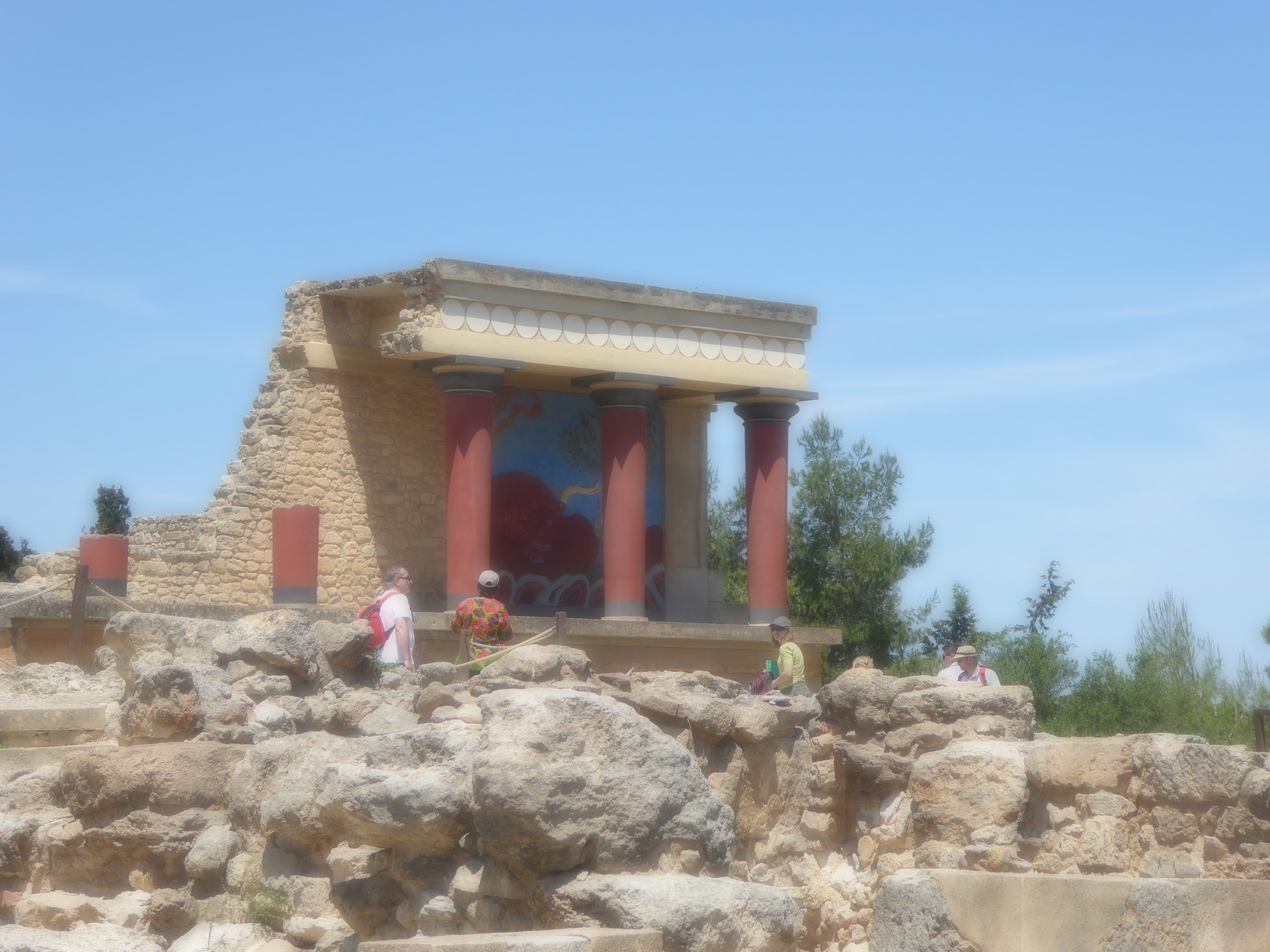
 We moved into landlubber mode for a week,
joining them not only for walking, but for sightseeing and enthusiastic sampling of
local delicacies. We visited Minoan Knossos – palace of the staggeringly ancient first
European civilisation, with its controversial restorations which we found quite helpful
in envisaging the palace. Highlight of the week was walking the awesome Samaria Gorge –
11 miles with 1200 metres of descent– not much less than Ben Nevis. The terrain was
difficult – loose rock and pebbles all the way. Were told by a guide that in 26 years of
walking the gorge she had never seen so much water, due to the unusually heavy rainfall
over winter. While this added to the beauty of the gorge, two days earlier a large
number of walkers had been trapped overnight by a flash flood and the walk was made more
difficult by the numerous river crossings over precarious stepping stones, rather than
the normal stroll along the dry riverbed. The only downside was Julia's painful loss of
two big toenails over the following week.
We moved into landlubber mode for a week,
joining them not only for walking, but for sightseeing and enthusiastic sampling of
local delicacies. We visited Minoan Knossos – palace of the staggeringly ancient first
European civilisation, with its controversial restorations which we found quite helpful
in envisaging the palace. Highlight of the week was walking the awesome Samaria Gorge –
11 miles with 1200 metres of descent– not much less than Ben Nevis. The terrain was
difficult – loose rock and pebbles all the way. Were told by a guide that in 26 years of
walking the gorge she had never seen so much water, due to the unusually heavy rainfall
over winter. While this added to the beauty of the gorge, two days earlier a large
number of walkers had been trapped overnight by a flash flood and the walk was made more
difficult by the numerous river crossings over precarious stepping stones, rather than
the normal stroll along the dry riverbed. The only downside was Julia's painful loss of
two big toenails over the following week.
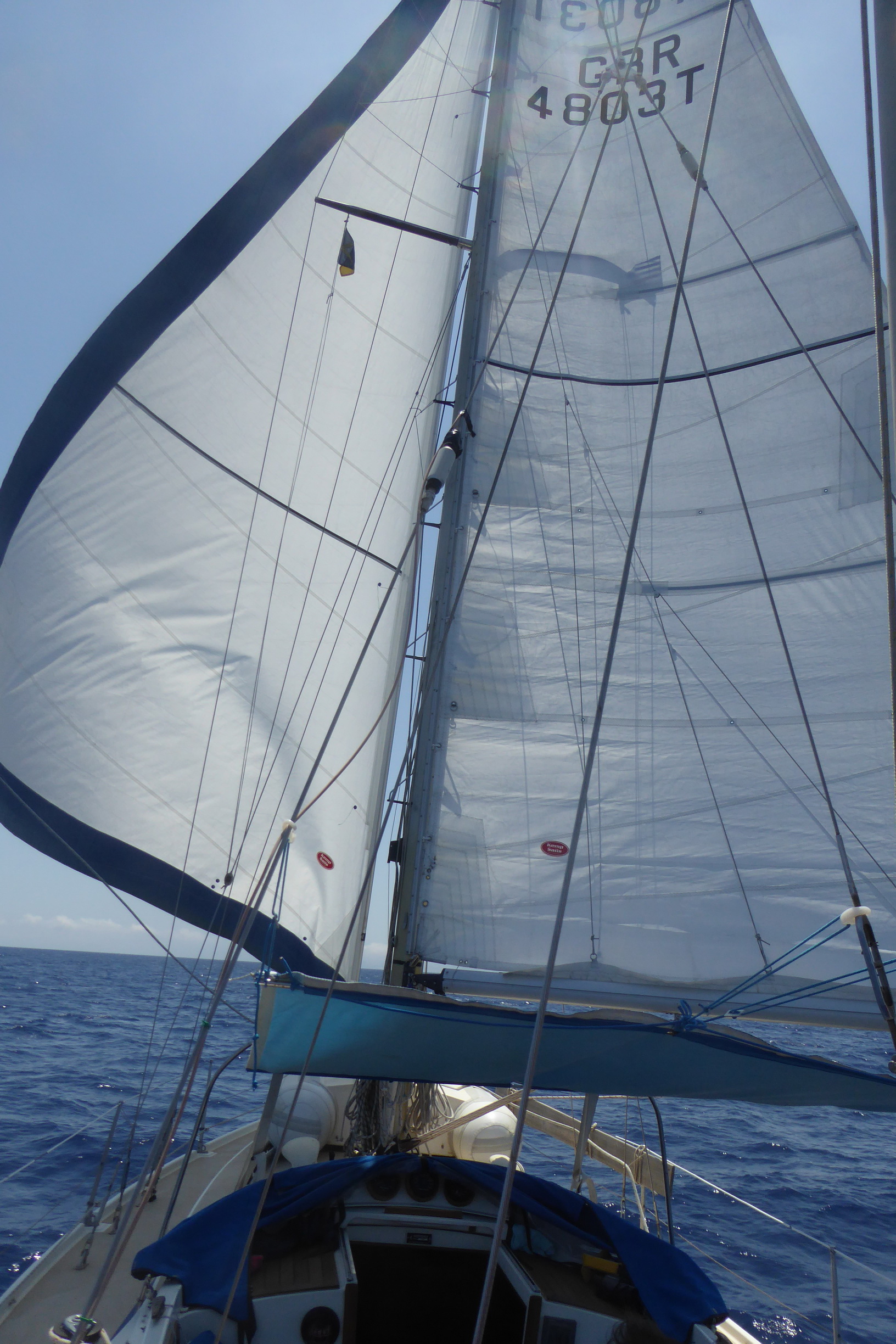 When the week was up we reverted to sailing mode and after a day completing our final
preparations we set off with walker Bob, for a gentle cruise eastwards along the coast
from Rethymno. On the first day, the forecast wind did not materialise, so we motored to
Ormos Bali, a resort 17 miles along the coast, where we anchored for the night in
slightly rolly conditions. Our progress was not helped by the veritable forest of weed
which had sprouted on the hull over the winter. The passage was uneventful, apart from
readings of apparently high and fluctuating oil pressure. However, after investigation
this turned out to be a fixable problem with the gauge, rather than the engine, so all
was well. Light relief was provided by the sighting of three cavorting turtles. The
following day a westerly wind gave us good sailing and we goose-winged the 23 miles to
Nisos Dhia, a barren island 7 ½ miles off the coast at Heraklion. We anchored in flat
water in a deserted bay whose main feature was a curious little shrine situated in a
cave at the water's edge.
When the week was up we reverted to sailing mode and after a day completing our final
preparations we set off with walker Bob, for a gentle cruise eastwards along the coast
from Rethymno. On the first day, the forecast wind did not materialise, so we motored to
Ormos Bali, a resort 17 miles along the coast, where we anchored for the night in
slightly rolly conditions. Our progress was not helped by the veritable forest of weed
which had sprouted on the hull over the winter. The passage was uneventful, apart from
readings of apparently high and fluctuating oil pressure. However, after investigation
this turned out to be a fixable problem with the gauge, rather than the engine, so all
was well. Light relief was provided by the sighting of three cavorting turtles. The
following day a westerly wind gave us good sailing and we goose-winged the 23 miles to
Nisos Dhia, a barren island 7 ½ miles off the coast at Heraklion. We anchored in flat
water in a deserted bay whose main feature was a curious little shrine situated in a
cave at the water's edge. 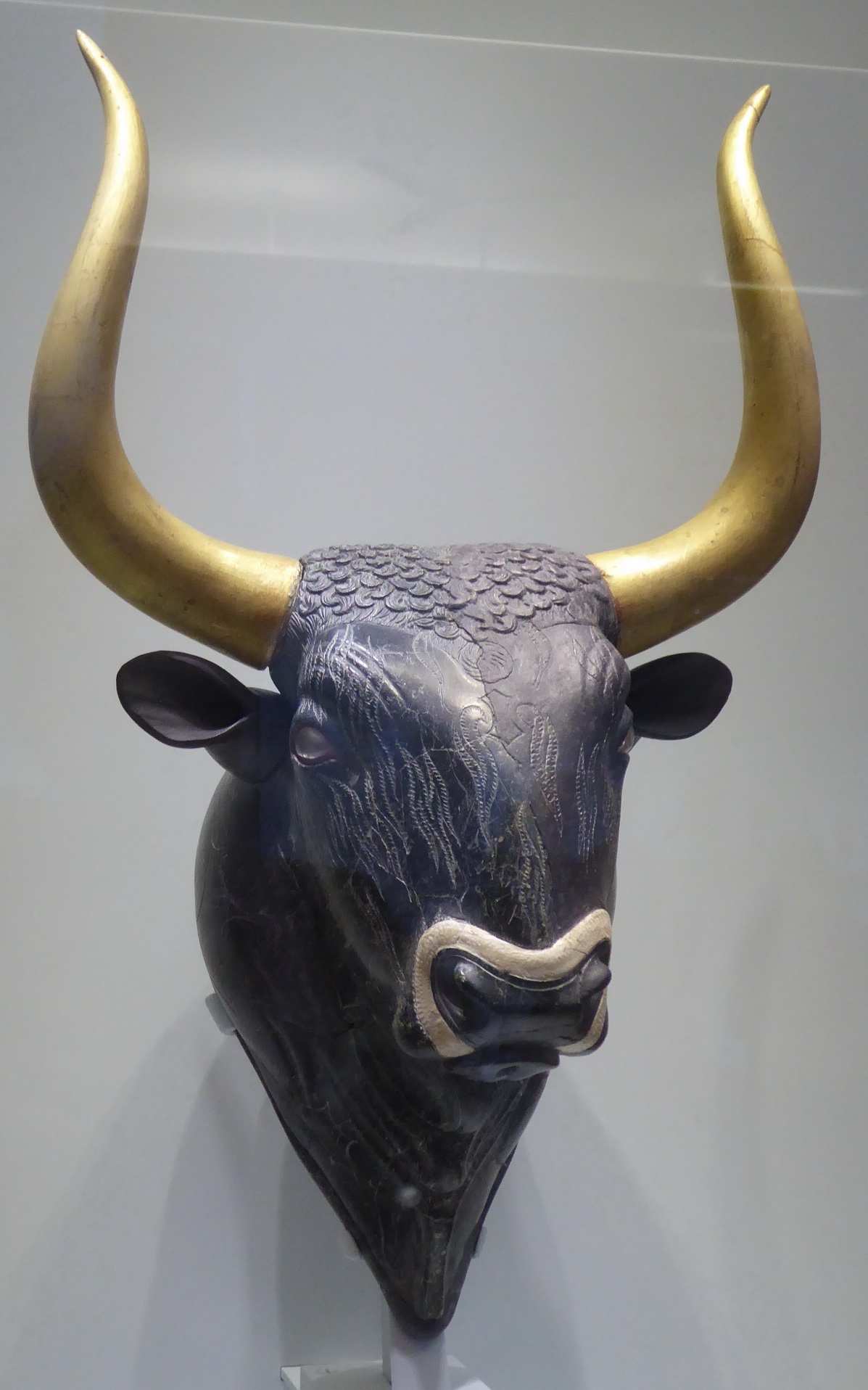 The rest of the day was spent checking out Heraklion's two superb museums. The
Archeological Museum full of artifacts from Knossos and numerous other ancient sites in
Crete – the age, number, quality and beauty of the exhibits was awesome. Then on to the
Historical Museum of Crete - much smaller – taking Cretan history through to the hard
fight for independence and on to the Second World War which was particularly
interesting.
The rest of the day was spent checking out Heraklion's two superb museums. The
Archeological Museum full of artifacts from Knossos and numerous other ancient sites in
Crete – the age, number, quality and beauty of the exhibits was awesome. Then on to the
Historical Museum of Crete - much smaller – taking Cretan history through to the hard
fight for independence and on to the Second World War which was particularly
interesting. 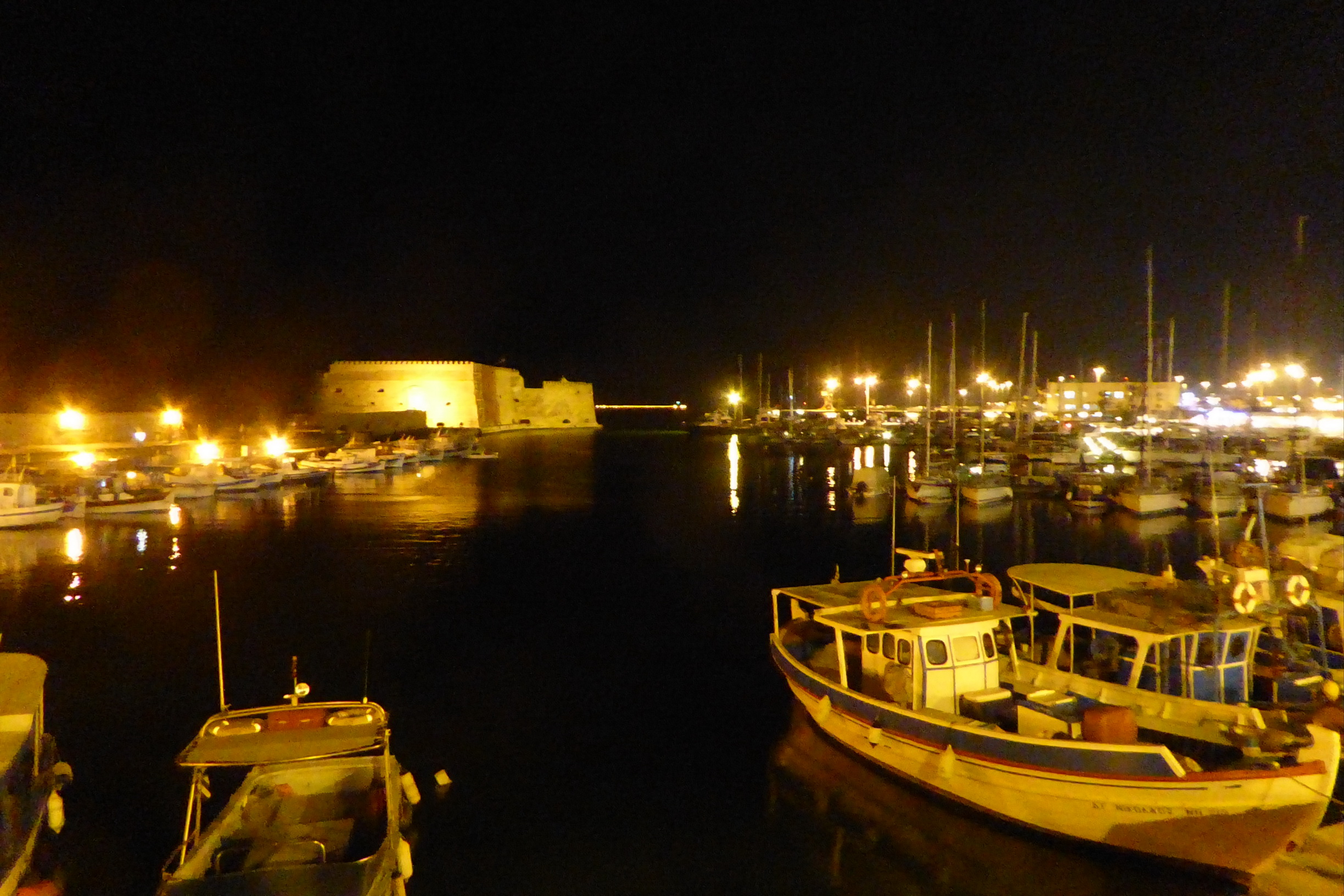 Heraklion has a pretty awful reputation. True, it has
execrable architecture and, apart from the Venetian harbour with its magnificent
arsenals and fortress, only a handful of minor sights. It can only be described as
scruffy, dusty and unlovely. However, its bustling and lively friendliness belie its
description as 'one of the least pleasant cities of the Mediterranean'. We enjoyed a
very good meal out to celebrate our wedding anniversary. Having met when each in our
early days of sailing, it is always hard to believe where we have got to in our own boat
over the years.
Heraklion has a pretty awful reputation. True, it has
execrable architecture and, apart from the Venetian harbour with its magnificent
arsenals and fortress, only a handful of minor sights. It can only be described as
scruffy, dusty and unlovely. However, its bustling and lively friendliness belie its
description as 'one of the least pleasant cities of the Mediterranean'. We enjoyed a
very good meal out to celebrate our wedding anniversary. Having met when each in our
early days of sailing, it is always hard to believe where we have got to in our own boat
over the years. 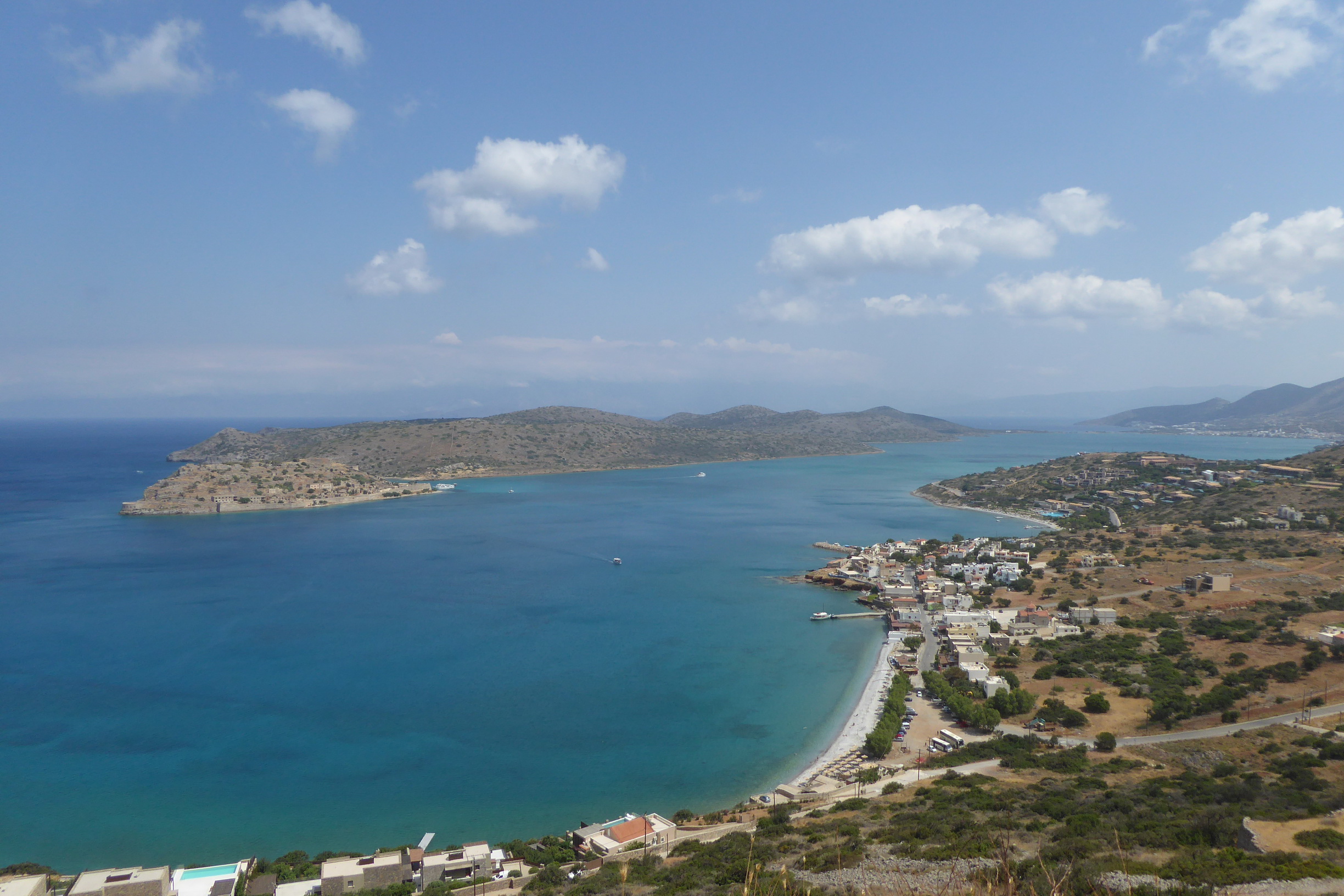 Finally, into Spinologa Lagoon to anchor in a quiet bay. Here we spent a few supremely
relaxing days – reading, swimming, walking ashore, a few minor jobs and mooching around
the lagoon anchoring at various locations to visit the pleasant little resort of
Elounda, the isthmus forming the southern end of the lagoon and most interestingly the
fascinating and picturesque Spinolonga island – iconic Venetian fort and later Leper
Colony.
Finally, into Spinologa Lagoon to anchor in a quiet bay. Here we spent a few supremely
relaxing days – reading, swimming, walking ashore, a few minor jobs and mooching around
the lagoon anchoring at various locations to visit the pleasant little resort of
Elounda, the isthmus forming the southern end of the lagoon and most interestingly the
fascinating and picturesque Spinolonga island – iconic Venetian fort and later Leper
Colony. 
